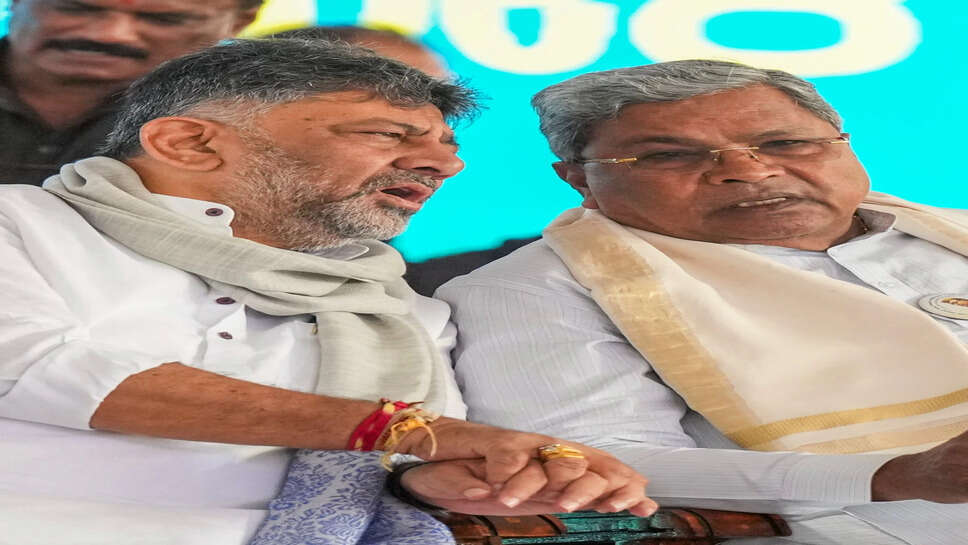Power Struggle in Karnataka: Congress Faces Internal Crisis as CM and Deputy CM Clash

The long-simmering power struggle between Karnataka Chief Minister Siddaramaiah and Deputy Chief Minister DK Shivakumar has now erupted into the open, threatening to destabilize the Congress government in the southern state. As tensions escalate, the Congress high command has been forced to intervene, holding urgent meetings with both leaders in an effort to contain the growing discord and preserve the party’s unity ahead of crucial electoral battles.
Cracks in the Coalition
When the Congress swept to power in Karnataka in 2023, it was clear that balancing power between the two tallest leaders in the state—Siddaramaiah and DK Shivakumar—would be a delicate act. While Siddaramaiah brought his mass appeal and administrative experience to the table, Shivakumar’s organizational strength and loyalty to the party, especially during tough times, made him indispensable.
The Congress attempted to placate both factions by offering Siddaramaiah the CM’s chair and Shivakumar the post of Deputy CM along with the powerful irrigation and Bengaluru development portfolios. But simmering rivalries have since only grown stronger, and recent developments have exposed the fault lines.
Public Posturing Turns Aggressive
Over the past few weeks, both leaders have made a series of veiled—and increasingly direct—statements that have fueled speculation about a full-blown rift. Siddaramaiah’s loyalists have been hinting at the CM completing a full five-year term, despite earlier talk of a mid-term change to accommodate Shivakumar. In contrast, Shivakumar’s supporters are beginning to openly speak of “rotational leadership” and “promises made by the high command.”
Matters came to a head when differences emerged over cabinet expansion, appointments to boards and corporations, and allocation of funds to various constituencies. Shivakumar’s camp believes that districts loyal to him are being sidelined in development funds, while Siddaramaiah’s group argues that governance decisions cannot be held hostage to factional demands.
The once behind-the-scenes power play has now spilled into the public domain, with party workers aligning themselves openly with either leader—adding to the sense of internal instability.
High Command’s Balancing Act
Alarmed by the growing tensions, the Congress high command has stepped in to control the damage. Senior leaders, including Congress President Mallikarjun Kharge and Rahul Gandhi, have reportedly held separate meetings with Siddaramaiah and Shivakumar to defuse the situation. Sources suggest that the central leadership has reminded both leaders of the importance of unity, especially with the upcoming local body elections and the need to preserve the party’s image in Karnataka—a rare state-level stronghold after recent setbacks elsewhere.
The leadership is said to be exploring formulas to placate both sides, including greater autonomy in party functioning for Shivakumar and more clarity on the promised power-sharing formula.
The Root of the Rift
At the heart of the conflict is ambition and legacy. Siddaramaiah, nearing the end of his political career, is keen on leaving behind a legacy of governance and social justice, while fulfilling his longstanding ambition of completing a full term as Chief Minister. On the other hand, DK Shivakumar, a powerhouse of resources and political maneuvering, believes it is now his time to lead, especially given his sacrifices during the 2019 political crisis and his pivotal role in Congress’ 2023 victory.
For Shivakumar, the delayed recognition and lack of clear commitment from the central leadership have only intensified frustration among his supporters. Adding fuel to the fire are murmurs within the party that some top leaders are wary of Shivakumar’s growing influence, both politically and financially.
The Risk to Governance
While the Congress tries to manage the optics, the power tussle is beginning to impact governance. Several welfare schemes and infrastructure projects are reportedly stuck due to bureaucratic delays stemming from ministerial turf wars. Conflicting directives from camps loyal to the two leaders have created confusion in the administration, and civil servants are said to be treading cautiously to avoid offending either side.
The resulting slowdown is not going unnoticed by the public. Opposition parties like the BJP and JD(S) have seized the opportunity to target the Congress government, accusing it of being “preoccupied with internal squabbles” rather than focusing on governance.
Political Fallout
The timing of the power struggle couldn’t be worse for Congress. With Lok Sabha elections behind and local elections ahead, Karnataka remains a crucial state for the party to showcase its model of governance. Any instability here could derail its national messaging, especially at a time when the Congress is trying to rebuild its political capital.
Furthermore, if the feud escalates, it could result in a repeat of the 2019 crisis that saw the Congress-JD(S) government collapse after defections—a scenario the party can ill afford now.
There is also a growing fear that prolonged factionalism could lead to an exodus of leaders and MLAs to rival parties, especially with BJP keen to rebuild its base in Karnataka under new leadership.
What’s at Stake for Shivakumar and Siddaramaiah?
For Siddaramaiah, who enjoys wide support among backward classes and minorities, retaining the CM post is not just about power—it’s about securing his place in history as one of Karnataka’s most influential leaders. His welfare schemes, such as Anna Bhagya and Gruha Lakshmi, have boosted his popularity and he hopes to carry forward these programs without interruption.
Shivakumar, on the other hand, has built his political career brick by brick, weathering income tax raids, arrests, and internal sabotage. He views the CM chair as a rightful reward and sees any delay or denial as a betrayal of the party’s promise.
Their individual stakes are now in conflict with the party’s broader need for unity and performance.
Possible Scenarios Ahead
Several scenarios are being discussed within party circles. One option is a publicly announced mid-term transition date, allowing Siddaramaiah to serve for a fixed period before handing over to Shivakumar. Another is expanding Shivakumar’s role within the organization or entrusting him with key electoral responsibilities at the national level.
Alternatively, the Congress may choose to maintain status quo and focus on damage control, relying on the political maturity of both leaders to avoid open confrontation. However, such a strategy carries the risk of slow erosion of public trust and administrative efficiency.
A Test for Congress’ Leadership
The Shivakumar-Siddaramaiah tussle is more than just a state-level conflict—it is a litmus test for the Congress’ ability to manage strong regional satraps, balance ambitions, and maintain power. As the high command scrambles to stitch together a compromise, the outcome will have implications not only for Karnataka’s governance but for the Congress’ fortunes across southern India.
